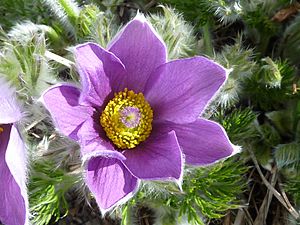Barnsley Warren facts for kids
| Site of Special Scientific Interest | |

Example - pasqueflower (Pulsatilla vulgaris)
|
|
| Area of Search | Gloucestershire |
|---|---|
| Coordinates | 51°45′22″N 1°55′18″W / 51.7562°N 1.9217°W |
| Interest | Biological |
| Area | 61.3 hectares |
| Notification | 1954 |
Barnsley Warren is a very special natural area in Gloucestershire, England. It covers about 61 hectares, which is like 150 football fields! This place is known as a Site of Special Scientific Interest (SSSI). This means it's protected because it has important plants, animals, or geological features. Barnsley Warren was first recognized as an SSSI in 1954.
The area sits in a dry valley with steep sides. You can find it northeast of Cirencester in the beautiful Cotswolds region. It's also listed as a Key Wildlife Site, showing how important it is for nature. Since the Countryside and Rights of Way Act was passed, Barnsley Warren is also "access land." This means people are welcome to visit and explore its natural beauty.
Contents
The Amazing Pasqueflower Reserve
Inside Barnsley Warren, there's a special part called the Gloucestershire Pasqueflower Reserve. This smaller area, about 5.3 hectares, is looked after by the Gloucestershire Wildlife Trust. It's a really important spot for a beautiful flower called the pasqueflower (Pulsatilla vulgaris).
Why the Pasqueflower is Special
You'll find more pasqueflowers here than anywhere else in the Cotswolds. This area is actually the western edge of where this flower naturally grows in Europe. The pasqueflowers bloom in late April or early May. Imagine seeing over twenty thousand of these lovely purple flowers!
The reserve is on a slope that faces southwest. The ground here is made of a type of rock called Oolitic limestone. The soil is thin, but it gets richer down in the valley. There's also a special "winterwell" in one corner. This well fills with water in winter and becomes the start of the Ampney Brook.
Other Cool Plants and Animals
Besides the pasqueflower, Barnsley Warren is home to many other interesting plants. These include the man orchid (Aceras anthropophorum) and the musk orchid (Herminimum monorchis). You can also spot slender bedstraw (Galium pumilum) and chalk milkwort (Polgala calcarea). Look out for round-headed rampion (Phyteuma tenerum) and bastard-toadflax (Thesium humifusum) too!
Butterflies and Bugs Galore
The wide variety of flowers and grasses makes Barnsley Warren a perfect home for many insects. It's especially good for butterflies and bugs. You might see small blue, chalkhill blue, and dark green fritillary butterflies fluttering around. A special bug called the cydnid shield bug, Sehirus dubius, loves to feed on the bastard-toadflax plant. Even a tiny creature like the heath snail lives here. Finding this snail is a sign that the grassland is very old and natural.
Protecting Barnsley Warren
To keep this special place healthy, the land is carefully grazed. This helps stop certain grasses, like upright brome and tor-grass, from growing too much. By managing the grazing, the unique plants and flowers, like the pasqueflower, can continue to thrive.

